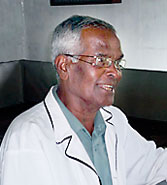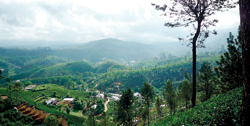Nestling in the hills above Nuwara Eliya the sleepy town of Kandapola are several so-called “high production” tea estates, towering between 600 – 1,200 metres above sea level. Once a large flourishing estate, the Hethersett Tea Garden was closed down in the early 1970s when it was unable to keep up with global competition in the tea market.
 |
| The tea man M.V. Natarajah |
Travel company Aitken Spence cleverly converted the disused tea factory into the eponymous Tea Factory hotel in 1996. A year later, the small surrounding Hethersett Tea Garden spread over 24 acres inaugurated the Mini Tea Factory, producing quality teas for in-house use. An added bonus to the charming scenery is having experienced tea maker and taster, M.V. Natarajah at hand to show guests around. “Learning the quirks of tea making and tasting, getting to grips with the flavour and quality, is a bit like wine tasting. If the tea has a bad, smoky taste, I know it’s been over-fired at about 800C,” he says his pride shining through in the way he conducts the tours.
Completing his education near Kandy in the mid 1960s, Mr Natarajah was hired for a short internship by Michael Waring, General Manager of the Hethersett Tea Estate. He was swiftly promoted to factory supervisor and 4th assistant tea maker at the neighbouring Courtlodge Factory within a couple of years. His best years were spent at Park Estate tea gardens in Kandapola. Following his retirement, he spent a year at the Ambewella Warwick Estate, before returning to the Mini Tea Factory at the turn of the millennium.
Mr Natarajah is only too pleased to go through the paces of tea manufacture, and also delve into the history of the Hethersett Estate. Leaves from the lush Camellia sinensis tea bushes are delicately hand-picked by the six female workers living on the estate, “an average day yielding 16 kilograms of leaves per worker,” he declares.
 “Their expert hands pick 2 leaves and a bud and 3 leaves and a bud, which are ultimately combined to make good quality black tea. First off, the young tea plants spend 5 – 6 years in the nursery; they are then re-planted in the garden, where they are pruned now and then to accelerate growth.” Amazingly, the life span of a tea bush may be anywhere from 45 – 75 years. “Their expert hands pick 2 leaves and a bud and 3 leaves and a bud, which are ultimately combined to make good quality black tea. First off, the young tea plants spend 5 – 6 years in the nursery; they are then re-planted in the garden, where they are pruned now and then to accelerate growth.” Amazingly, the life span of a tea bush may be anywhere from 45 – 75 years.
“The first 10 days of the harvest are spent picking the flush; only the best, top leaves are chosen for the next stage in the withering section, where the leaves are spread out to reduce their moisture content by nearly 50%,” explains Mr Natarajah. At the Tea Factory, withering mostly takes place under natural atmospheric conditions, over 15 – 18 hours. During the rainy season, a more efficient, artificial form of withering using hot air speeds up the process,. The post-withered rubbery leaves are put into the rolling machine and the orthodox “twisting and curling” method is applied. Incrementally increasing pressure on the leaves, half an hour at a time, imparts the right strength to the tea.
“A sieving process follows the roll breaker; the small leaves are filtered out and spread at 3 inch thickness on a fermentation table, where they are kept from anywhere between half and hour to 3 hours, depending on the weather,” says Mr Natarajah.
Through oxidation, their colour changes from greenish to copper, releasing the delicious scent of oranges. The fluid bed dryer is their next destination, where they are further desiccated for an hour, and then to the stalk extractor, where, as the name suggests, the stalk and fibre are separated from the bulk black tea.
Tea is then graded in the rotary sifter; the five meshes determining the size. Largest is the number 10 mesh, from which emerges the naturally-flavoured Pekoe tea. From the number 12 comes Pekoe mild, from number 16 Broken Orange Pekoe (commonly abbreviated to BOP), which is a lighter version. Then the stronger breakfast tea drunk with milk, Broken Orange Pekoe Fannings (BOPF) from mesh 24 and finally, tea dust from mesh 30, which is the strongest version, intended for tea bags.
The rotary sifter ingeniously separates the leaves into different containers for ease of packing. “All the tea is organically farmed; the only compost used is made from wheat straw,” beams Mr Natarajah. As an aside, he passionately explains that “green tea is derived by a steaming process using 2 leaves and a bud. Following a very brief steaming of less than 5 minutes, the hand-curled leaves are dried and packed.”
Living with his extended family on one of the Kandapola estates, Mr. Natarajah also attends to the family business of cultivating their vegetable plot of leeks, carrots and beet for sale. It is truly remarkable, the amount of energy Mr Natarajah brings to his job as tea connoisseur extraordinaire; reassuringly, this is reflected in the superior taste exuding from the Mini Tea Factory tea. |


 “Their expert hands pick 2 leaves and a bud and 3 leaves and a bud, which are ultimately combined to make good quality black tea. First off, the young tea plants spend 5 – 6 years in the nursery; they are then re-planted in the garden, where they are pruned now and then to accelerate growth.” Amazingly, the life span of a tea bush may be anywhere from 45 – 75 years.
“Their expert hands pick 2 leaves and a bud and 3 leaves and a bud, which are ultimately combined to make good quality black tea. First off, the young tea plants spend 5 – 6 years in the nursery; they are then re-planted in the garden, where they are pruned now and then to accelerate growth.” Amazingly, the life span of a tea bush may be anywhere from 45 – 75 years.